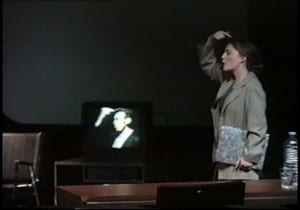After reading about Fiona Templeton and Michael Ramtomski’s performance Recognition it triggered some thoughts for me about how we could use the multimedia in our performance. We have discussed using pre recordings and projections but how close can we cut that line between the solid performance happening for the audience and the multimedia? I was touched how Ramtomski lived on through this performance after his death through the power of multimedia in performance.
Image: Online: http://presence.stanford.edu:3455/Collaboratory/352 (accessed: 3rd March 2013).
The piece involves Templeton interacting with a video of her late collaborator Ramtomski and a woman you cannot see which is presumably her. “She speaks words that are repeated moments later by the man in the video, or by her own voice recorded on the video; she turns the sound down and speaks words aloud as the man mouths them; she speaks in time with her own voice on the video and she speaks in his voice.” ((Baker, Clive (2000) New Theatre Quarterly 63, Cambridge: University Press p.208)). In the book New Theatre Quarterly 63 they describe the performance and how Templeton made the absent present through multimedia not only by playing a video of Michael Ramtomski but interacting with the media to make that presence much more real. A similar piece I saw was a third year student’s solo performance which I assume was inspired by Templeton’s work, where he used 3 different videos of himself and interacted with each one individually, each represented him in the past, one within hours, one within days and one slightly more. As he had this very convincing conversation with them he proceeded to inform them of the performance they will be taking part in (the one he was currently in). This type of performance evidently takes a vast amount of time and dedication however it could be used within our piece as due to health and safety reasons not all performers can be present for each performance.
